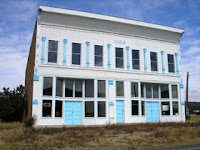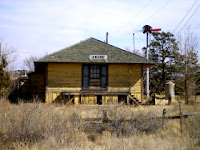 We are worried as we set out this morning -- Tucson, Arizona got inches of snow dumped on it last night and here in Socorro County, everything is laced with ice crystals. The storm from Arizona is supposed to move eastward, predicting to dump 6-10 inches on Silver City, New Mexico, our final destination for the day. We're going to be traveling some mountain roads and is this unpredictable storm going to put a damper on our next few days of travel? Well, we're here, we have coats, water, food and a 4-wheel drive jeep -- let's just see what happens.
We are worried as we set out this morning -- Tucson, Arizona got inches of snow dumped on it last night and here in Socorro County, everything is laced with ice crystals. The storm from Arizona is supposed to move eastward, predicting to dump 6-10 inches on Silver City, New Mexico, our final destination for the day. We're going to be traveling some mountain roads and is this unpredictable storm going to put a damper on our next few days of travel? Well, we're here, we have coats, water, food and a 4-wheel drive jeep -- let's just see what happens. As we venture south from Socorro, the landscape is absolutely beautiful! Cactuses glitter in the bright sun, dripping as the temperature rises. As the black highway heats up under, a misty cloud forms over it. We've started early and very glad of it, because all the ice and dusting of snow is entirely gone by 11:00 a.m. There is no wind and the sun is proving that this will be a wonderful day.
 We soon venture off the highway, heading westward on a stretch of the Geronimo Trail Scenic Byway to the small agricultural communities of Placita and Monticello. We are awe inspired as we reach Monticello Canyon and view the small town of Placita (meaning Little Plaza), with its snow covered fields and mountain back drop. The community, dating back to the 1840's still boasts its 1916 San Lorenzo Catholic Church and several old homes.
We soon venture off the highway, heading westward on a stretch of the Geronimo Trail Scenic Byway to the small agricultural communities of Placita and Monticello. We are awe inspired as we reach Monticello Canyon and view the small town of Placita (meaning Little Plaza), with its snow covered fields and mountain back drop. The community, dating back to the 1840's still boasts its 1916 San Lorenzo Catholic Church and several old homes.  Just two more miles down the road we come to Monticello, a farming and ranching community dating back to 1856. The town was built in a square to protect residents from Apache attacks. Ironically, it later became the headquarters for the Southern Apache Agency before a post was established at nearby Ojo Caliente in 1874. This picturesque small community continues to sport its 1867 San Ignacio Catholic Church, the ruins of an old school that burned years ago, and a number of homes, some still lived in, and others that are succumbing to nature's elements.
Just two more miles down the road we come to Monticello, a farming and ranching community dating back to 1856. The town was built in a square to protect residents from Apache attacks. Ironically, it later became the headquarters for the Southern Apache Agency before a post was established at nearby Ojo Caliente in 1874. This picturesque small community continues to sport its 1867 San Ignacio Catholic Church, the ruins of an old school that burned years ago, and a number of homes, some still lived in, and others that are succumbing to nature's elements.  Backtracking just a bit, we next head for more ghost towns, starting with 1880 mining town of Winston, which was once called home to about 3,000 people. The old settlement provides a number of photo opportunities in its old business buildings and homes. About three miles down the road is another mining community - Chloride. This ghost town has seen much restoration in the last several years and its museum was open for us to learn more of its history.
Backtracking just a bit, we next head for more ghost towns, starting with 1880 mining town of Winston, which was once called home to about 3,000 people. The old settlement provides a number of photo opportunities in its old business buildings and homes. About three miles down the road is another mining community - Chloride. This ghost town has seen much restoration in the last several years and its museum was open for us to learn more of its history. We then try to take a short cut over a forest road so that we don't have to backtrack once again. Alas, this is not a good idea, as the snow covered road is unpaved, rutted, and narrow. Ok, backtrack we do, heading south again on I-25 through Truth or Consequences before getting off the interstate once again, headed for, yes, you guessed it -- more ghost towns.
 Heading westward on NM-152, we soon arrive at Hillsboro, another mining community born in 1877. Though not a ghost town today, it displays lots of interesting historic buildings. Another 9 ½ miles down the road, we almost miss the turnoff to Kingston and do a quick U-turn to this old 1882 mining town. Now, at one time this place was allegedly one of the largest and wildest towns in New Mexico Territory, with some 7,000 people. Hmmmm, sure can't tell it today -- only a old buildings and a cemetery, but still worth the stop.
Heading westward on NM-152, we soon arrive at Hillsboro, another mining community born in 1877. Though not a ghost town today, it displays lots of interesting historic buildings. Another 9 ½ miles down the road, we almost miss the turnoff to Kingston and do a quick U-turn to this old 1882 mining town. Now, at one time this place was allegedly one of the largest and wildest towns in New Mexico Territory, with some 7,000 people. Hmmmm, sure can't tell it today -- only a old buildings and a cemetery, but still worth the stop.  We take a brief pause to take pics of the open pit Santa Rita Copper Mine and feeling pretty DONE for the day, head on over to Silver City. Nope! Change of plans when I spy the sign for Fort Bayard. Ok, one last stop as we make a quick tour through the old fort grounds. Lots of buildings left, but like Fort Stanton, is another sad case of deterioration. The site now serves as a New Mexico State Hospital.
We take a brief pause to take pics of the open pit Santa Rita Copper Mine and feeling pretty DONE for the day, head on over to Silver City. Nope! Change of plans when I spy the sign for Fort Bayard. Ok, one last stop as we make a quick tour through the old fort grounds. Lots of buildings left, but like Fort Stanton, is another sad case of deterioration. The site now serves as a New Mexico State Hospital. Ok, finally really done, find the hotel and "die." It's been a very long day.











